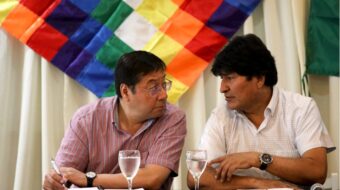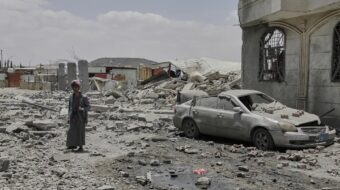There were celebrations throughout Pakistan after President Pervez Musharraf resigned Aug. 18. Jubilant crowds gave out sweets and congratulated each other for the democratic victory, one daily newspaper, The Frontier Post, reported.
“Today, the shadow of dictatorship that has prevailed for long over this country, that chapter has been closed. It hasn’t happened very easily. We passed through a long struggle and we had come very close to the process of initiating impeachment,” said Information Minister Sherry Rehman, a member of the Pakistan People’s Party, the party of slain former Prime Minister Benazir Bhutto.
Musharraf, the former general of Pakistan’s army, came to power in a coup in 1999 ousting then-Prime Minister Nawaz Sharif.
A staunch ally of the Bush administration’s “war on terror,” Musharraf was facing impeachment by the ruling parliamentary coalition on charges he violated the nation’s constitution. An overwhelming majority of the Pakistani people – 85 percent according to a poll by the GOP-connected International Republican Institute – wanted Musharraf to resign. A majority of Pakistanis in urban areas said they think life will get better with Musharraf gone.
But that is the big question confronting Pakistan’s delicate democracy. Will the PPP now led by Bhutto’s husband, Asif Azari, along with its main coalition partner, Sharif’s Pakistan Muslim League – N, be able to put aside competing interests and govern this complex and crisis-ridden country?
Pakistan has been under military rule for most of its 61-year history. The army has been woven into every aspect of Pakistani life. Army-run businesses control significant sections of the economy, including construction.
The economy is in shambles. The nation’s 165 million people are suffering from soaring prices on food, fuel and other necessities.
In his resignation speech, Musharraf sought to prettify his nine-year rule, but he is largely blamed for much of the crisis. Pakistan’s failure to build power plants has resulted in regular and prolonged blackouts. This has contributed to a massive flight of capital out of the country. Within a half hour of Musharraf’s resignation, Pakistan’s stock market reportedly rose 500 points.
Pakistan has received billions of dollars in military aid from the U.S., which used the country as a launching pad for operations against the former Soviet Union and the left-led Afghanistan government in the 1970s and ’80s. The destabilizing results of that military relationship continue to reverberate today.
Pakistani people in provinces bordering Afghanistan face daily terror from shadowy groups using the garb of extremist religion. Women and girls are particularly targeted. These criminal groups run drugs and arms to and from Afghanistan.
According to The New York Times, Musharraf did “little to undercut the power of extremist clerics in the nation, or to curb the Taliban and other militant groups, which had long been used by Pakistan’s intelligence services to exert influence in India and Afghanistan.”
The Bush administration ignored or even encouraged this, seeing Musharraf as a useful and compliant partner in the U.S. drive to dominate the region, politically, economically and militarily.
Bush (and John McCain) justified backing Musharraf against the will of the Pakistani people, arguing that it was necessary to prevent extremists from taking over the nuclear-armed nation.
Yet, the reality in Pakistan is that the extremist forces have very little support among the people. In the February elections, extremist right-wing clerical parties got even lower vote totals than the tiny percentage won by Musharraf’s party.
Recently, under pressure, the army has stepped up its campaign against Taliban-like forces in the border areas. This has resulted in some 300,000 people fleeing their homes and seeking refuge in camps, which are inadequately staffed and lack food, water and other basic supplies, according to an urgent appeal for help sent out by the Pakistan Peace and Solidarity Council. (For more info: pscpak@gmail.com.)
Now many Pakistanis worry that with Musharraf gone there will be no common purpose to unite the two opposition parties that now lead a tenuous governing coalition, and a power struggle will ensue. Currently the two parties are debating whether to reinstate the chief judge dismissed by Musharraf last year, provoking a tidal wave of protest by Pakistan’s legal community. Pakistan People’s Party leader Ariz favors keeping the new chief justice named by Musharraf, while the Muslim League’s Sharif campaigned on reinstating the former judge, a position shared by many Pakistanis.
Under Pakistan’s constitution, the chairman of the Parliament’s Senate, Mohammedmian Soomro, is now acting president. A new president must be elected within 30 days by members of both houses of Parliament and the four provincial assemblies.
talbano @pww.org









